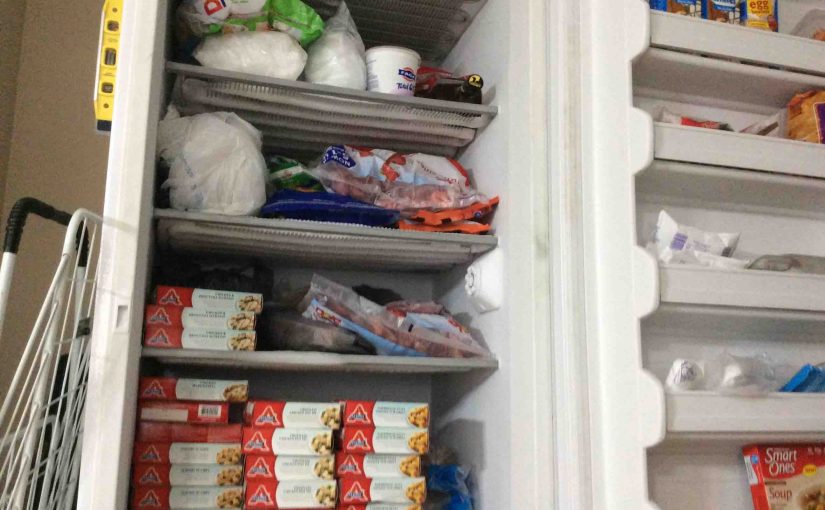We’ve found this way to be best to defrost most any freezer. It works fast, is safe, and supports easy cleanup. This works for frost free as well as manual defrost models, as long as you can safely aim your heat source toward the inside.
We’ve rented several apartments that had manual-defrost freezers. Indeed at this very moment, we have a stand-up Frigidaire commercial freezer here, that requires annual defrosting to keep clear the cooling coils built into each of its shelves.

We’ve only tried this defrost freezer procedure on upright, vertical units (those with a plum positioned door). But this method will defrost a chest freezer also (those with a horizontally-positioned door on top). In that case, just find a place above the freezer from which to aim the heat gun down into the open chamber, instead of up from the floor as the routine below shows.
For either chest or upright freezer defrosting, heat guns and hair dryers work well. Heat guns work the best because unlike hairdryers, they have a built-in stand that allows you to easily sit them on the floor (or on a nearby shelf or chair for the chest freezer case) and aiming the hot air through the open freezer door.
So to defrost our Frigidaire freezer, we perform the following procedure every six months:
Best Way to Defrost Any Freezer: Step by Step
1. Disconnect Freezer from Power
Unplug the freezer, without touching its thermostat. Leaving this alone preserves its current temperature setting.
2. Prop Freezer Door Open
Then, block open the freezer door with a board. Take care not to force it too far wide, lest you break the hinges, the door, or the freezer case itself.
3. Move All Freezer Contents to Insulated Coolers
Next, remove all food items to a couple of insulated coolers nearby so that frozen meat, vegetables, and bread, remain frozen throughout this routine.
4. Get your Heat Source Ready, to Continue with Best Way to Defrost Any Freezer
Next, aim the hot air device from the floor up into the inner chamber. Next, turn it on, making sure that you turn its intake vent completely open. This gives maximum hot air discharge with the least chance of overheating.
5. Watch that Ice Buildup Disappear
Then, wait until all the ice inside melts; periodically mopping up the floor at the freezer’s front. This can take the better part of an hour for heavily accumulated ice.
6. Every so Often, Wipe up Water
Many freezers feature a drain plug that you can open, as well as a drain tube that you can route into a drain or bucket. However, if not, or you can’t use that draining facility, wipe up the ice water as it trickles down into the bottom.
7. Done with the Heat Source
Once all the ice goes away, turn off the heat gun / hair dryer, and set it in a safe place to cool, away from furniture, draperies, carpets, and other items that it could burn.
8. Clean Inside of the Unit to Continue with Best Way to Defrost Any Freezer
Then, wash out the interior with a soapy cloth and warm water, and rinse it out with another clean cloth. The interior may still be near freezing cold. So spending too much time on this step may chill your hands. Therefore, be fast about it.
9. Thoroughly Dry Inside
Then, dry out the inside of the freezer with a few old but clean bath towels. You want to leave as little water behind as possible, so as to lengthen the time before the next required defrosting. You will likely need at least several towels for this.
10. Power Up the Unit Again
Wipe off the power cord, especially the AC plug end. Make sure there’s not dirt or corrosion on the prongs. If so, clean it up. Also, inspect the cord for damage at this time, and replace if frayed, nicked, stiff, or it shows any other signs of aging.
11. Move all Food Back into the Freezer
As you replace each food item, wipe off any wetness from condensation or melting ice. To avoid having to defrost again for as long as possible, you’ll want to assure that your food containers are as dry as possible before storing them again in the freezer.
Best Way to Defrost Any Freezer: Cautions and Warnings
Do Not Use Flame Producing Heat Sources !
Avoid using blowtorches, kerosene heaters, and such because these can start a fire or damage this appliance. Simply put, they’re just not safe for this job.
Risk of Severe Burns
Of course, caution is the word of the day when defrosting a freezer with any heating device. At close range, an 1875-watt heat gun for example can generate significantly hotter (and thus, more dangerous) air than a hairdryer does. So position the heat gun at least two feet from the open freezer to assure that by the time that hot air reaches the freezer’s inside walls and shelves, that it has cooled sufficiently so as not to melt any plastic parts therein.
Watch Out for Falling Ice and Water
Also consider that some large chunks of ice and much water (perhaps a gallon or two in the worst cases) will fall out as defrosting continues, and collect on the floor. So be sure to place plenty of towels in front of the freezer on the floor, and position the heat source close enough for effective defrosting yet far enough away that the water and ice do not spill on it.
Risk of Electric Shock
Keep the heat source and cord well clear of the dripping water and ice, and to virtually eliminate the risk of electrocution. That appliance should feature the third (grounding) prong on its power cable, and you should plug it into a GFI outlet, and avoid using long extension cords.
